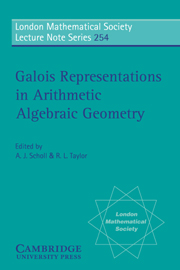Book contents
- Frontmatter
- Contents
- Preface
- List of participants
- Lecture programme
- 1 The Eigencurve
- 2 Geometric trends in Galois module theory
- 3 Mixed elliptic motives
- 4 On the Satake isomorphism
- 5 Open problems regarding rational points on curves and varieties
- 6 Models of Shimura varieties in mixed characteristics
- 7 Euler systems and modular elliptic curves
- 8 Basic notions of rigid analytic geometry
- 9 An introduction to Kato's Euler systems
- 10 La distribution d'Euler-Poincaré d'un groupe profini
9 - An introduction to Kato's Euler systems
Published online by Cambridge University Press: 23 March 2010
- Frontmatter
- Contents
- Preface
- List of participants
- Lecture programme
- 1 The Eigencurve
- 2 Geometric trends in Galois module theory
- 3 Mixed elliptic motives
- 4 On the Satake isomorphism
- 5 Open problems regarding rational points on curves and varieties
- 6 Models of Shimura varieties in mixed characteristics
- 7 Euler systems and modular elliptic curves
- 8 Basic notions of rigid analytic geometry
- 9 An introduction to Kato's Euler systems
- 10 La distribution d'Euler-Poincaré d'un groupe profini
Summary
Introduction
In the conference there was a series of talks devoted to Kato's work on the Iwasawa theory of Galois representations attached to modular forms. The present notes are mainly devoted to explaining the key ingredient, which is the Euler system constructed by Kato, first in the K2-groups of modular curves, and then using the Chern class map, in Galois cohomology. This material is based mainly on the talks given by Kato and the author at the symposium, as well as a series of lectures by Kato in Cambridge in 1993. In a companion paper [29] Rubin explains how, given enough information about an Euler system, one can prove very general finiteness theorems for Selmer groups whenever the appropriate L-function is non-zero (see §8 of his paper for precise results for elliptic curves).
Partly because of space, and partly because of the author's lack of understanding, the scope of these notes is limited. There are two particular restrictions. First, we only prove the key reciprocity law (Theorem 3.2.3 below), which allows one to compute the image of the Euler system under the dual exponential map, in the case of a prime p of good reduction (actually, for stupid reasons explained at the end of §2.1, we also must assume p is odd). Secondly, we say nothing about the case of Galois representations attached to forms of weight greater than 2. For the most general results, the reader will need to consult the preprint [17] and Kato's future papers.
Kato's K2 Euler system has its origins in the work of Beilinson [1] (see also [30] for a beginner's treatment).
Information
- Type
- Chapter
- Information
- Galois Representations in Arithmetic Algebraic Geometry , pp. 379 - 460Publisher: Cambridge University PressPrint publication year: 1998
Accessibility standard: Unknown
Why this information is here
This section outlines the accessibility features of this content - including support for screen readers, full keyboard navigation and high-contrast display options. This may not be relevant for you.Accessibility Information
- 17
- Cited by
